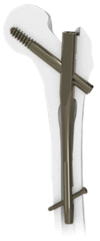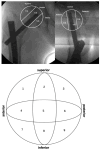Clinical Outcomes in the Treatment of Pertrochanteric Femur Fractures: A Retrospective Cohort Study
- PMID: 40423073
- PMCID: PMC12113484
- DOI: 10.3390/jpm15050202
Clinical Outcomes in the Treatment of Pertrochanteric Femur Fractures: A Retrospective Cohort Study
Abstract
Background: Pertrochanteric fractures of the proximal femur present a common challenge for traumatologists, with intramedullary nailing emerging as the preferred treatment. Complication rates are around 20%, including screw jamming, refractures, implant breakage, or medial migration, with cut-out being the most common. A tip-apex distance (TAD) of >25 mm and incorrect cephalic screw position are predictive factors for cut-out. This study assesses outcomes using the Elos intramedullary nail, based on the experience of the Department of Orthopedics and Traumatology at Ospedale Maggiore in Bologna. Methods: We conducted a retrospective cohort study of 344 patients treated with the Elos intramedullary nail for pertrochanteric femoral fractures from 1 January 2017 to 31 December 2022. The Elos®-Intrauma nail was implanted using the standard technique. Initial X-rays classified fractures according to the AO-OTA classification, and postoperative X-rays confirmed the cephalic screw's placement per Cleveland's regions. Patients were divided into two groups: optimal cephalic screw position (positions 5-8-9) and other positions. We evaluated TAD, calcar-referred TAD (CalTAD), and postoperative reduction quality using Chang's criteria. The incidence of cut-out and other complications were assessed in connection with these measurements. Results: Among the 344 patients, 227 (65.9%) had the screw in positions 5-8-9, while 117 (34.1%) had it in other positions. The median TAD was 19.47 ± 6.26 mm (range 3.96-46.6), with TAD ≤ 25 mm in 265 patients (77%). The median CalTAD was 22.37 ± 5.65 mm (range 8.75-45.3), with CalTAD ≤ 25 mm in 231 patients (67.1%). According to Chang's criteria, 8 cases (2.3%) had poor reduction, 139 cases (40.4%) had acceptable reduction, and 197 cases (57.3%) had excellent reduction. Cut-out occurred in four cases (1.19%). Multivariate analysis revealed only poor reduction and TAD > 25 mm as independent predictors of cut-out (p < 0.05), while cephalic screw position, CalTAD, and fracture type did not impact cut-out incidence. Conclusions: This study indicates that optimal TAD and quality of reduction are crucial for minimizing cut-out risks. The Elos intramedullary nail shows favorable outcomes with a low cut-out incidence when these parameters are met. Emphasis should be placed on achieving a TAD ≤ 25 mm and excellent reduction quality to reduce complications.
Keywords: CalTAD; TAD; cephalic screw positioning; cut-out; intramedullary nailing; pertrochanteric fractures.
Conflict of interest statement
The authors declare no conflicts of interest.
Figures
References
-
- Società Italiana di Ortopedia e Traumatologia Fratture del Femore Prossimale Nell’Anziano. Linea Guida SIOT. 2021. [(accessed on 10 January 2022)]. Available online: https://siot.it/lineeguida-fratturafemore2021/
-
- Pascarella R., Fantasia R., Maresca A., Bettuzzi C., Amendola L., Violini S., Tigani D.S. How evolution of the nailing system improves results and reduces orthopedic complications: More than 2000 cases of trochanteric fractures treated with the Gamma Nail System. Musculoskelet. Surg. 2016;100:1–8. doi: 10.1007/s12306-015-0391-y. - DOI - PubMed
LinkOut - more resources
Full Text Sources
Miscellaneous





